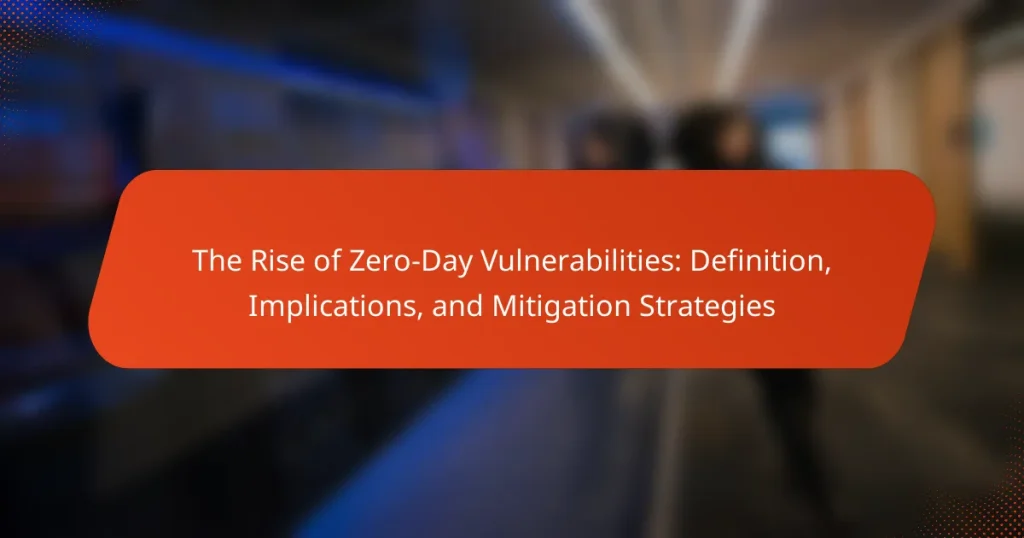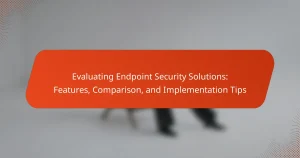Zero-day vulnerabilities are security flaws in software that remain unknown to the vendor, leaving them unpatched and open to exploitation by attackers. These vulnerabilities pose significant risks, leading to data breaches and system compromises, with 25% of breaches involving zero-day exploits, according to the 2021 Verizon Data Breach Investigations Report. The financial implications are severe, with the average cost of a data breach approximated at $4.24 million. To combat these threats, organizations must adopt a multi-layered security approach, including regular software updates, intrusion detection systems, application whitelisting, vulnerability assessments, employee training, and robust incident response plans. Implementing these strategies can significantly reduce the impact of zero-day attacks.
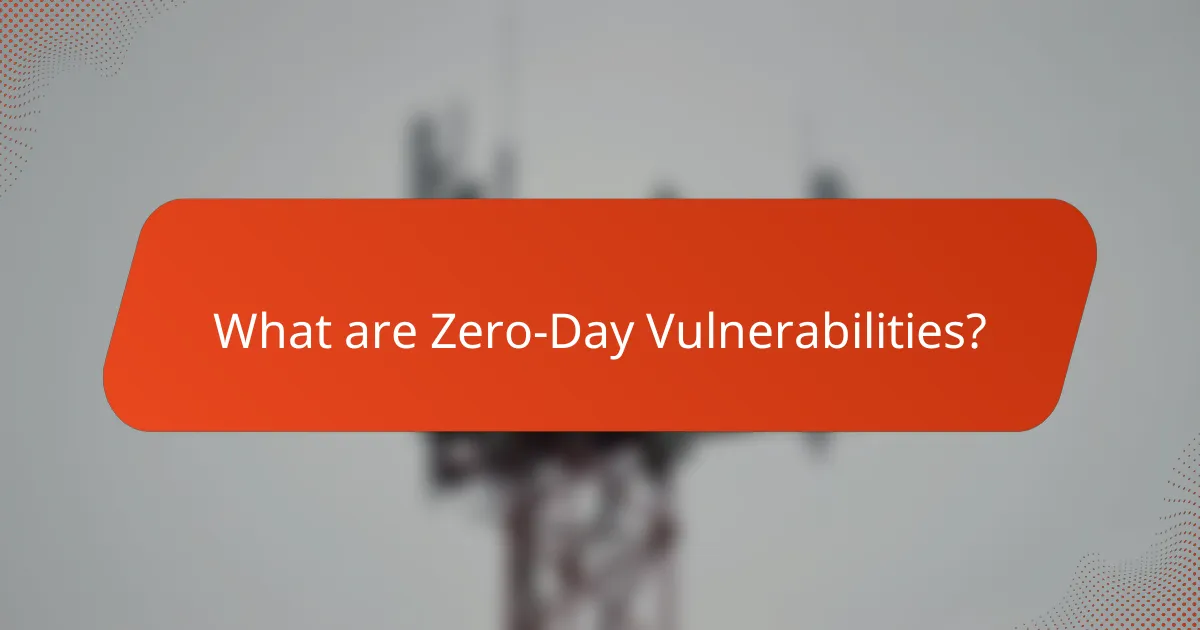
What are Zero-Day Vulnerabilities?
Zero-day vulnerabilities are security flaws in software that are unknown to the vendor. They are called “zero-day” because the developer has had zero days to fix the issue. Attackers exploit these vulnerabilities before they are discovered and patched. This can lead to significant data breaches and system compromises. According to the 2021 Verizon Data Breach Investigations Report, 25% of breaches involved zero-day vulnerabilities. The existence of such vulnerabilities poses serious risks to organizations and individuals alike.
How do Zero-Day Vulnerabilities occur?
Zero-day vulnerabilities occur when software flaws are discovered by attackers before the vendor is aware of them. These vulnerabilities can arise from coding errors or oversights in software development. Attackers exploit these flaws to gain unauthorized access or execute malicious code. Once a zero-day vulnerability is identified, it can be used to target systems until a patch is released. The term “zero-day” refers to the fact that the vendor has zero days to fix the vulnerability before it can be exploited. According to a report by Symantec, 60% of vulnerabilities are exploited within a month of discovery. This highlights the urgency for software developers to address potential security issues promptly.
What is the lifecycle of a Zero-Day Vulnerability?
A zero-day vulnerability lifecycle consists of several distinct phases. Initially, the vulnerability is discovered by an attacker or researcher. This phase is known as the “discovery” phase. Next, the vulnerability remains unknown to the software vendor and the public, making it a “zero-day” vulnerability.
Once the vulnerability is exploited by attackers, it enters the “exploitation” phase. During this time, attackers may use it to gain unauthorized access or control over systems. The exploitation can lead to data breaches, malware installation, or other malicious activities.
The next phase occurs when the vendor becomes aware of the vulnerability. This is referred to as the “notification” phase. The vendor then works on creating a patch or fix. This leads to the “remediation” phase, where the patch is released to users.
After the patch is applied, the vulnerability is no longer considered a zero-day. It enters the “post-exploitation” phase. In this phase, systems are updated, and users are encouraged to apply the patch to protect against future attacks.
The lifecycle highlights the critical importance of timely updates and proactive security measures. Zero-day vulnerabilities can pose significant risks until they are identified and mitigated.
What factors contribute to the emergence of Zero-Day Vulnerabilities?
Zero-Day Vulnerabilities emerge due to several key factors. Software complexity increases the likelihood of undiscovered flaws. As software becomes more intricate, more potential vulnerabilities can exist. Lack of comprehensive testing contributes to this issue as well. Inadequate testing often fails to identify hidden bugs. Additionally, the rapid pace of software development can lead to oversights. Developers may prioritize speed over thoroughness, resulting in vulnerabilities. The growing sophistication of cyber attackers also plays a role. Attackers continuously evolve their techniques, finding new ways to exploit weaknesses. Finally, the use of third-party components can introduce vulnerabilities. These components may not be thoroughly vetted, leading to security gaps.
Why are Zero-Day Vulnerabilities significant in cybersecurity?
Zero-day vulnerabilities are significant in cybersecurity because they represent unknown security flaws in software. These vulnerabilities can be exploited by attackers before developers have a chance to issue a patch. The lack of awareness regarding these flaws makes them particularly dangerous. Cybercriminals can use zero-day exploits to gain unauthorized access to systems, steal data, or launch attacks. According to a report by the Ponemon Institute, the average cost of a data breach caused by such vulnerabilities can reach millions of dollars. Additionally, zero-day vulnerabilities can lead to widespread damage, affecting not only individual users but also entire organizations and critical infrastructure. Their elusive nature complicates detection and prevention efforts, heightening the risk for all users.
What are the potential consequences of Zero-Day Vulnerabilities?
Zero-day vulnerabilities can lead to significant security breaches. They allow attackers to exploit software flaws before developers release patches. This exploitation can result in data theft, unauthorized access, and system compromise. Organizations may suffer financial losses due to these attacks. A report by the Ponemon Institute indicates that the average cost of a data breach is $3.86 million. Additionally, zero-day vulnerabilities can damage an organization’s reputation. Customers may lose trust in a brand that suffers frequent breaches. Regulatory fines and legal consequences may also arise from inadequate security measures. Overall, the impact of zero-day vulnerabilities can be severe and far-reaching.
How do Zero-Day Vulnerabilities impact organizations and individuals?
Zero-day vulnerabilities significantly impact organizations and individuals by exposing them to unpatched security risks. These vulnerabilities allow attackers to exploit systems before developers can issue fixes. Organizations may face data breaches, financial losses, and reputational damage due to these exploits. Individuals can experience identity theft, loss of personal data, and unauthorized access to accounts. According to the 2020 Verizon Data Breach Investigations Report, 70% of breaches involved external actors exploiting vulnerabilities. The average cost of a data breach in 2021 was $4.24 million, highlighting the financial implications for organizations. Therefore, both entities must prioritize cybersecurity measures to mitigate these risks.
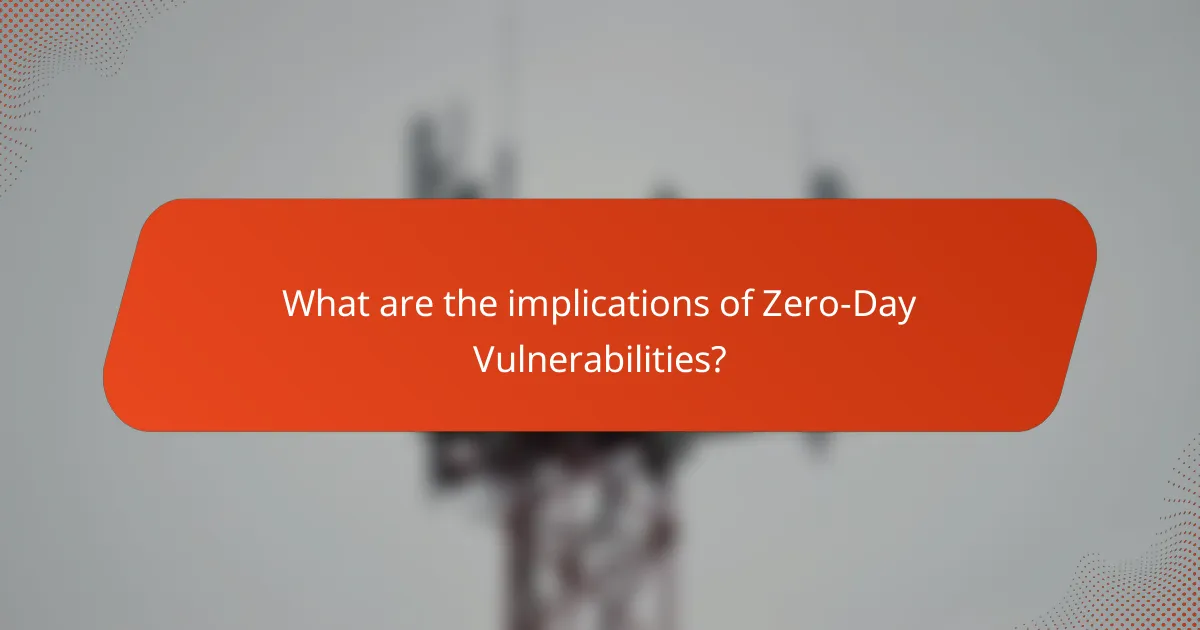
What are the implications of Zero-Day Vulnerabilities?
Zero-Day Vulnerabilities have significant implications for cybersecurity. They represent flaws in software that are exploited before the vendor releases a fix. This can lead to unauthorized access, data breaches, and system compromises. Organizations face increased risks of financial loss and reputational damage. The average cost of a data breach is approximately $4.24 million, according to IBM’s Cost of a Data Breach Report 2021. Additionally, zero-day exploits can be used in targeted attacks, making them a preferred method for cybercriminals. The lack of immediate patches creates a window of opportunity for attackers. As a result, organizations must invest in proactive security measures and threat detection systems to mitigate these risks.
How do Zero-Day Vulnerabilities affect software development?
Zero-day vulnerabilities significantly impact software development by introducing unanticipated security risks. These vulnerabilities arise from flaws in software that developers are unaware of at the time of release. When exploited, they can lead to data breaches, system compromises, and loss of user trust.
The presence of zero-day vulnerabilities forces developers to prioritize security in their coding practices. This often results in increased development time and costs. According to a study by the Ponemon Institute, the average cost of a data breach involving zero-day vulnerabilities can reach millions of dollars.
Additionally, developers must continuously monitor for new vulnerabilities after software deployment. This ongoing vigilance requires resources and can disrupt planned development cycles. Overall, zero-day vulnerabilities necessitate a proactive approach to security in software development.
What challenges do developers face in addressing Zero-Day Vulnerabilities?
Developers face significant challenges in addressing Zero-Day Vulnerabilities. These vulnerabilities are unknown to the software vendor and can be exploited by attackers. The primary challenge is the lack of awareness about these vulnerabilities. Developers may not have the necessary information to identify and mitigate them. Additionally, the rapid pace of software development complicates timely updates. Developers often struggle to prioritize security alongside feature development. Limited resources and expertise in cybersecurity can hinder effective responses. Furthermore, testing for Zero-Day Vulnerabilities requires sophisticated tools and methodologies. The evolving nature of threats makes it difficult to stay ahead of potential exploits.
How can Zero-Day Vulnerabilities influence software testing practices?
Zero-day vulnerabilities significantly influence software testing practices by necessitating more rigorous testing protocols. These vulnerabilities are undisclosed flaws that attackers exploit before developers can address them. Consequently, software testing must incorporate proactive measures to identify potential zero-day vulnerabilities. This includes adopting advanced techniques like fuzz testing and threat modeling. Organizations often increase the frequency of security assessments in response to emerging zero-day threats. Additionally, integrating automated tools for continuous monitoring becomes essential. Research shows that companies implementing these practices reduce the risk of exploitation. For example, a study by the Ponemon Institute found that organizations with proactive security measures experienced 50% fewer security incidents. Thus, zero-day vulnerabilities compel software testing to evolve towards a more security-focused approach.
What are the legal and ethical considerations surrounding Zero-Day Vulnerabilities?
Legal considerations surrounding zero-day vulnerabilities include laws on software security and liability. Organizations may face legal action if they fail to protect user data from exploitation. Ethical considerations involve the responsibility of researchers and companies to disclose vulnerabilities. The debate centers on whether to report findings to the public or to the affected companies. Ethical guidelines suggest prioritizing user safety and transparency. Additionally, the use of zero-day vulnerabilities by governments raises issues of surveillance and privacy. Historical context shows that the 2016 Equifax breach was partly due to unaddressed vulnerabilities. This incident led to significant legal repercussions and public outcry.
What regulations exist regarding the disclosure of Zero-Day Vulnerabilities?
Regulations regarding the disclosure of Zero-Day Vulnerabilities primarily fall under cybersecurity laws and frameworks. In the United States, the Computer Fraud and Abuse Act (CFAA) addresses unauthorized access to computers and networks. The Cybersecurity Information Sharing Act (CISA) encourages sharing information about vulnerabilities among private and public sectors. The General Data Protection Regulation (GDPR) in Europe mandates reporting data breaches, which can include Zero-Day Vulnerabilities. Furthermore, various industry standards, such as ISO/IEC 27001, provide guidelines for vulnerability disclosure. These regulations aim to enhance transparency and security in the digital landscape.
How do ethical hacking and responsible disclosure relate to Zero-Day Vulnerabilities?
Ethical hacking and responsible disclosure are crucial in addressing Zero-Day Vulnerabilities. Ethical hackers identify these vulnerabilities before malicious actors can exploit them. They test systems and report findings to the affected organizations. Responsible disclosure involves sharing vulnerability details with the vendor privately. This allows the vendor to develop a patch before public disclosure. The goal is to minimize risk to users. Studies show that timely disclosure can significantly reduce the window of exposure. For example, the 2016 Google Project Zero report highlighted this approach’s effectiveness in mitigating threats. Thus, ethical hacking and responsible disclosure play vital roles in enhancing cybersecurity against Zero-Day Vulnerabilities.
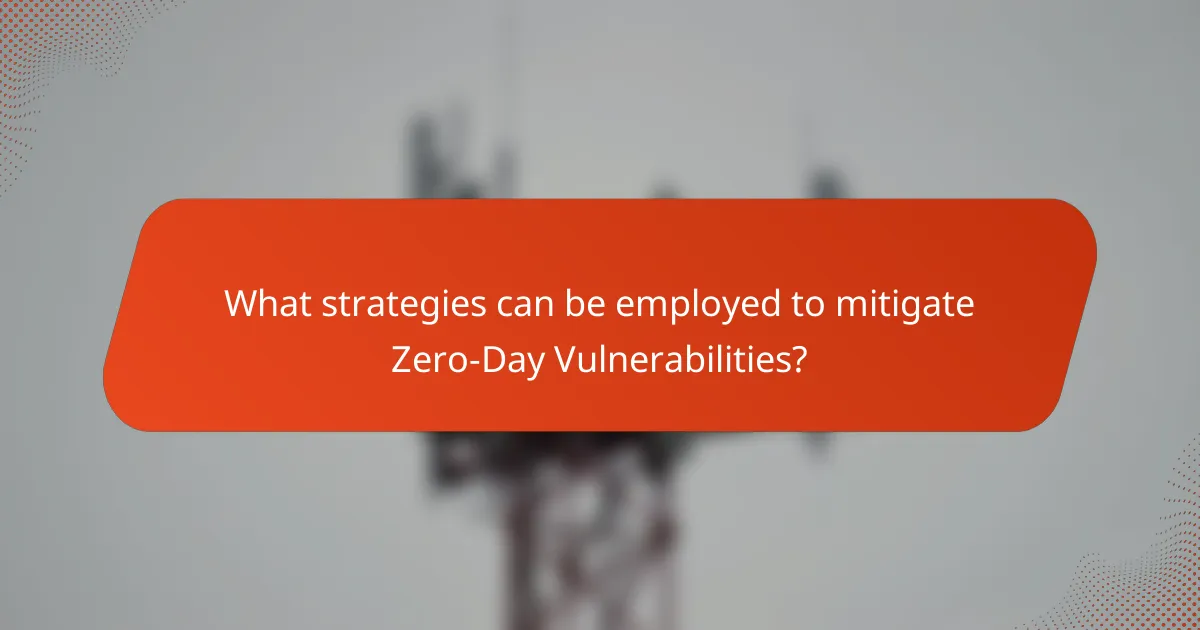
What strategies can be employed to mitigate Zero-Day Vulnerabilities?
Implementing a multi-layered security approach is essential to mitigate Zero-Day Vulnerabilities. Regular software updates can reduce exposure to known vulnerabilities. Employing intrusion detection systems helps identify unusual behavior indicative of exploitation attempts. Utilizing application whitelisting restricts the execution of unauthorized applications. Conducting regular vulnerability assessments identifies potential weaknesses in systems. Employee training on security best practices enhances awareness of phishing and social engineering attacks. Additionally, implementing a robust incident response plan ensures timely action when vulnerabilities are exploited. According to the Ponemon Institute, organizations that employ these strategies can reduce the impact of Zero-Day attacks significantly.
How can organizations proactively defend against Zero-Day Vulnerabilities?
Organizations can proactively defend against Zero-Day Vulnerabilities by implementing a multi-layered security strategy. This includes regular software updates and patch management to address known vulnerabilities promptly. Utilizing intrusion detection systems can help identify unusual activities that may indicate an exploit attempt. Conducting security audits and vulnerability assessments regularly can also reveal potential weaknesses in the system. Employee training on cybersecurity best practices is crucial to reduce the risk of human error. Additionally, adopting threat intelligence solutions can provide insights into emerging vulnerabilities and attack vectors. According to a report by the Ponemon Institute, organizations that invest in proactive security measures can reduce the impact of Zero-Day attacks significantly.
What role does threat intelligence play in mitigating Zero-Day Vulnerabilities?
Threat intelligence plays a crucial role in mitigating zero-day vulnerabilities. It provides organizations with timely information about emerging threats and vulnerabilities. This intelligence helps in identifying potential zero-day exploits before they can be leveraged by attackers. By analyzing threat data, organizations can enhance their security posture. Threat intelligence aids in prioritizing patching efforts based on the severity of threats. It also supports proactive defense strategies, enabling organizations to implement preventive measures. According to a report by the Ponemon Institute, organizations utilizing threat intelligence can reduce the average time to detect breaches by 50%. This demonstrates the effectiveness of threat intelligence in addressing zero-day vulnerabilities.
How can regular software updates and patch management reduce risks?
Regular software updates and patch management reduce risks by addressing vulnerabilities in software. These updates often include security patches that fix known weaknesses. By applying these patches, organizations can prevent exploitation by attackers. According to a report from the Ponemon Institute, 60% of data breaches result from unpatched vulnerabilities. Regular updates also enhance overall software performance and stability. This proactive approach significantly decreases the likelihood of successful cyberattacks. Furthermore, timely updates ensure compliance with security standards and regulations. Overall, consistent patch management is crucial for maintaining a secure IT environment.
What best practices should be implemented for Zero-Day Vulnerability management?
Implementing best practices for Zero-Day Vulnerability management includes proactive measures and rapid response strategies. Organizations should maintain an up-to-date inventory of all software and systems. Regularly patching software is crucial to mitigate risks. Employing intrusion detection systems enhances threat monitoring capabilities. Conducting vulnerability assessments helps identify weaknesses before they are exploited. Establishing an incident response plan ensures swift action when a zero-day vulnerability is discovered. Training employees on security awareness can reduce the likelihood of successful attacks. Collaborating with threat intelligence services provides insights into emerging vulnerabilities and exploits. These practices collectively strengthen an organization’s defense against zero-day vulnerabilities.
What incident response strategies are effective for addressing Zero-Day Vulnerabilities?
Effective incident response strategies for addressing Zero-Day Vulnerabilities include proactive measures and rapid detection. Organizations should implement continuous monitoring to identify unusual activities. This enables quick response to potential threats. Additionally, maintaining an up-to-date inventory of assets aids in vulnerability management.
Employing threat intelligence can provide insights into emerging vulnerabilities. Regular patch management processes are crucial for addressing known issues promptly. Incident response teams should conduct tabletop exercises to prepare for potential zero-day attacks.
Furthermore, establishing a communication plan ensures timely information sharing during incidents. These strategies collectively enhance an organization’s ability to mitigate the risks associated with zero-day vulnerabilities.
How can employee training enhance awareness of Zero-Day Vulnerabilities?
Employee training enhances awareness of Zero-Day Vulnerabilities by educating staff on their nature and risks. Training programs can explain what Zero-Day Vulnerabilities are, highlighting that they are security flaws exploited before a patch is available. This knowledge helps employees recognize potential threats in their daily tasks. Additionally, training can provide real-world examples of Zero-Day attacks, illustrating their impact on organizations. Employees trained in cybersecurity best practices are more likely to identify suspicious activity. According to a study by the Ponemon Institute, organizations with comprehensive training programs reduce their risk of breaches by up to 70%. Regular training updates ensure that employees stay informed about emerging threats. This proactive approach fosters a security-conscious culture within the organization.
What tools and resources are available for detecting and mitigating Zero-Day Vulnerabilities?
Tools for detecting and mitigating Zero-Day Vulnerabilities include Intrusion Detection Systems (IDS), antivirus software, and threat intelligence platforms. IDS tools monitor network traffic for suspicious activity. Antivirus software can identify known malware signatures and suspicious behavior. Threat intelligence platforms provide real-time information on emerging threats.
Resources for mitigation include security patches, vulnerability management tools, and security awareness training. Security patches fix known vulnerabilities in software. Vulnerability management tools help organizations identify and prioritize risks. Security awareness training educates employees on recognizing potential threats.
Examples of specific tools include Snort for intrusion detection, McAfee for antivirus, and Recorded Future for threat intelligence. These tools and resources are essential for proactive cybersecurity measures against Zero-Day Vulnerabilities.
What are the most effective software tools for vulnerability scanning?
The most effective software tools for vulnerability scanning include Nessus, Qualys, and Rapid7 InsightVM. Nessus is widely recognized for its comprehensive scanning capabilities and user-friendly interface. Qualys offers a cloud-based solution that provides continuous monitoring and vulnerability assessment. Rapid7 InsightVM integrates with other security tools to enhance threat detection. These tools are backed by extensive databases of known vulnerabilities, allowing for timely identification and remediation. Their effectiveness is evidenced by their widespread use in various organizations to mitigate security risks.
How can organizations leverage community resources for Zero-Day Vulnerability information?
Organizations can leverage community resources for Zero-Day Vulnerability information by actively participating in cybersecurity forums and threat intelligence sharing platforms. Engaging with communities helps organizations receive real-time updates on vulnerabilities. These platforms often provide insights from security researchers and industry experts. Collaboration with peers enables organizations to share experiences and solutions. Additionally, organizations can utilize open-source tools and databases that track Zero-Day vulnerabilities. Resources like the Common Vulnerabilities and Exposures (CVE) database offer structured information on known vulnerabilities. By integrating community-driven intelligence, organizations enhance their threat detection and response capabilities. This collective knowledge ultimately strengthens overall cybersecurity posture.
Zero-day vulnerabilities are undiscovered security flaws in software that can be exploited by attackers before the vendor is aware and able to issue a fix. This article examines the implications of zero-day vulnerabilities, including their lifecycle, how they occur, and the significant risks they pose to organizations and individuals, such as financial losses and reputational damage. It also discusses the factors contributing to their emergence, the impact on software development, and the legal and ethical considerations surrounding them. Furthermore, the article outlines effective strategies for mitigation, including proactive security measures, threat intelligence, and employee training to enhance awareness and response capabilities.
